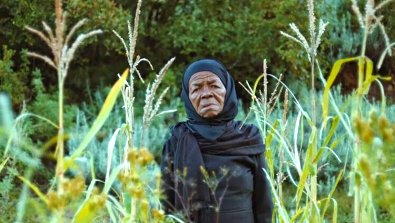 Inconsolable grief leads to resistance in a film from Lesotho combining mythic and political truth.
Inconsolable grief leads to resistance in a film from Lesotho combining mythic and political truth.
This Is Not a Burial, It’s a Resurrection. Like a myth or a folktale, the third feature film of Mosoto writer and director Lemohang Jeremiah Mosese announces its meaning beforehand with its title. But woven into that one sentence—this is not a burial, it’s a resurrection—are many other complex meanings concerning death, grief, ignorance, oppression, truth, courage, and more.
In a rural village in Lesotho, a small country in southern Africa, an 80-year old woman named Mantoa laments the death of her only son. Over the years she has experienced the death of her parents, her husband, her daughter and grandchild. But after all this, her son was there to still anchor her to the world. Now he is gone too. Eventually we piece together that he died in a mining accident, but we don’t know the full story behind any of these losses, only that Mantoa has survived her entire family. Now she no longer finds meaning in life.
Mantoa is played by an awe-inspiring veteran actress from South Africa, Mary Twala Mhlongo. She portrays overpowering grief with an intensity and conviction that is uncanny. And this was her final performance—Mary Twala died in 2020.
So…all Mantoa wants is to die and be buried in the graveyard with her family and the village ancestors. She assumes a grim silence, impervious to all efforts by the villagers to interact. The priest sits outside her door and tries to talk to her. He tells her about the death of his wife, and his long struggle to get through the grief. Mantoa hears him, she hears them all, but she’s immovable. Her face is like a mask of pain. Mosese seems to be presenting us with a modern day Book of Job. Religious teachings no longer make any sense to Mantoa. She has nothing but anger at God. She experiences all the attempts at consolation to be empty, and who could say that she is wrong in her point of view? Also like Job is her defiance, her refusal to look away from tragedy.
In this version of Job, however, there’s something more. When she complains about trash not being picked up in the graveyard, she finds out that the graveyard, and in fact the entire village, is going to be flooded, and everyone relocated because of a new dam that’s going to be built. The village head tells everyone that it’s all part of modern progress. The priest says they must accept the inevitable and trust God. But Mantoa sees that the unseen enemies, the businessmen and politicians who are planning this project, are taking away the very earth in which her family is buried, that is, the connection to ancestors, to shared history, and to the life that has been bound to this land for generations. What we’re not told, but what we can infer if we’ve studied colonialism, is that the practice of denying native ownership of the land has not ended with the country’s so-called independence. In this story, it’s the fate of a defiant old woman with nothing more to lose, to embody the force of resistance.
With starkly beautiful photography and an eerie musical score, the movie also uses a framing device that evokes an ironic mythos. An old storyteller narrates the film intermittently while playing a traditional stringed instrument called a lesiba. Yet this fabled figure is sitting in a rough-looking urban setting, sitting in the ruins of some tavern in a darkened city. We are in the real modern world, and we are also in the absolute world of ancient symbols. Mosese unites the high with the low in an experience both mystical and political. This Is Not a Burial, It’s a Resurrection.

An evil eye changes the appearance of two young people in love so that they can’t recognize one another, in a film from the...

Mario Monicelli’s 1963 comedy/drama about a strike by factory workers in 19th century Turin is not as well known as it should be. The...

One of the most unusual examples of propaganda ever filmed, made in the midst of the Second World War, imagines what it would be...